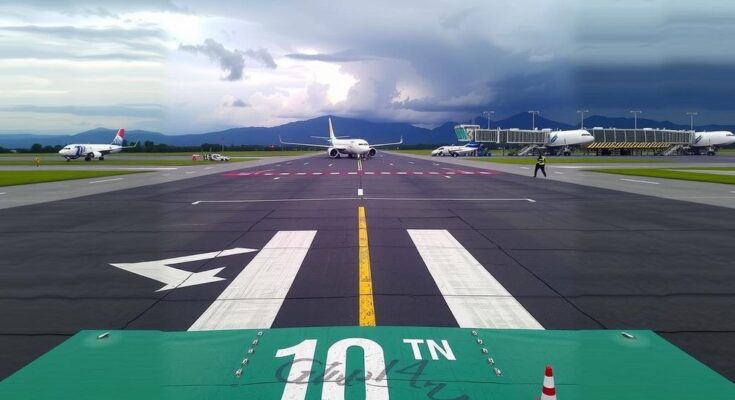Liberia International Airport temporarily closed operations on December 28 due to identified potholes on its runway, leading to flight delays and cancellations. The necessary repairs caused approximately four hours of disruption until operations resumed. Such runway issues are not uncommon at this airport, highlighting the essential need for regular maintenance to ensure safety and efficiency in air travel.
Daniel Oduber Quirós International Airport (LIR) in Liberia, Costa Rica, recently faced operational disruptions due to the identification of two potholes on its runway. The defects were deemed a safety hazard, prompting airport authorities to temporarily close the runway from approximately 16:00 to just before 20:00 on December 28. This closure resulted in significant flight delays and cancellations, with around eight aircraft awaiting takeoff once operations resumed. Such incidents are not unprecedented for this airport; it had previously experienced a similar main runway closure in mid-November, leading to over 35 international flights being affected. In light of these challenges, Costa Rican aviation officials emphasized the importance of safety while addressing runway maintenance.
The impact of runway maintenance on flight operations is a recurring theme worldwide. Airports often contend with balancing safety with operational efficiency, frequently necessitating temporary closures. The recent disruptions at LIR mirror similar occurrences at other international airports. For instance, an extensive repair project at Brisbane Airport involved replacing worn-out concrete segments and resulted in a reduction of available runway length affecting larger aircraft operations. Mumbai’s Chhatrapati Shivaji Maharaj International Airport exemplifies proactivity with scheduled maintenance aimed at mitigating rain-induced wear and tear, highlighting the global need for timely runway repair and upkeep.
Additionally, runway maintenance measures are vital for ensuring flight safety as they can considerably influence the routine of aircraft operations. Airports employ various cleaning methods to maintain runway surfaces by removing rubber accumulations from aircraft tires. This essential upkeep often takes place outside of peak hours to minimize disruptions to airline operations.
In summary, while the closure of the runway at Liberia International Airport posed immediate challenges, the situation underscores the critical importance of regular maintenance and safety protocols in aviation. The balance between necessary repairs and operational continuity remains a complex issue faced by airports around the globe, as demonstrated by the experiences at Daniel Oduber Quirós and other critical air travel hubs.
The safety and operational integrity of airport runways are paramount for effective aviation management. In many cases, runway maintenance requirements are driven by safety regulations that necessitate closing the runway to conduct repairs. This creates a balancing act between ensuring safe air travel and minimizing disruption to schedules. Heavy rainfall can exacerbate wear and tear on runways, as demonstrated by airports like Mumbai’s Chhatrapati Shivaji Maharaj International Airport, necessitating proactive maintenance schedules. Furthermore, excess rubber buildup from landing aircraft can lead to potential hazards if not properly managed, bringing forth the need for regular upkeep.
In conclusion, the recent closure of Daniel Oduber Quirós International Airport due to runway potholes highlights the ongoing challenges associated with airport maintenance and safety. While delays and cancellations disrupt travel, they serve to prioritize passenger safety above all. The situation at LIR reflects a larger pattern seen in international aviation, emphasizing the necessity for rigorous maintenance practices that ensure safe air travel amidst operational disruptions. Authorities must remain vigilant in addressing runway conditions to facilitate the smooth operation of air traffic and safeguard travelers.
Original Source: simpleflying.com




